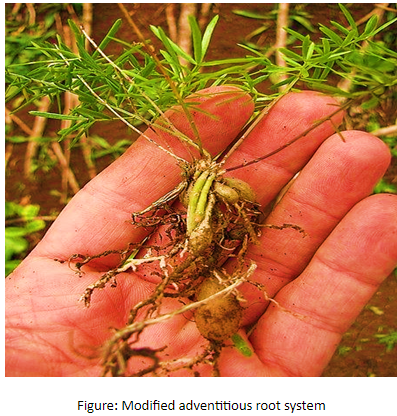
Which of the following is an example of a modified adventitious root?
(a)Carrot
(b)Radish
(c)Asparagus
(d)Rhizophora
Answer
579k+ views
Hint: The roots are mainly involved in the absorption of water and minerals from the soil. Roots in some plants undergo modifications in their shape and structure in order to perform functions like respiration, storage, and protection.
Complete answer:
‘Asparagus’ is an example of modified adventitious roots.
Modifications of Adventitious roots:
1. Food Storage
-Simple tuberous roots: These are swollen, creeping roots and do not acquire any shape. They are born singly always. They arise from nodes of prostrate stems and enter the soil. E.g. Sweet potato
-Fasciculated tuberous roots: It is a cluster of adventitious roots for the storage of food. These roots have a fixed shape. E.g. Asparagus
-Nodulose roots: Only apices of roots turn swollen like single beads. E.g. Ginger
-Moniliform or beaded roots: They have alternately swollen roots and beaded appearance. E.g. Grasses
-Annulated roots: These roots look like a number of discs placed one above another.
2. Support
-Prop roots: They arise from the branches of the stem for providing mechanical support to heavy branches as pillars. E.g. Banyan tree
-Stilt roots: They arise from the lower nodes of the stem to support the main axis and enter the soil obliquely. E.g. Maize
-Clinging roots: These are non absorptive roots arising either from nodes, internodes, or both. E.g. Ficus pumila
-Buttress roots: They are at the basal part of the stem and are vertically elongated and horizontally compressed. E.g. Ficus
3. Special functions
-Sucking or haustorial roots: These suck food and water from the host and are found in parasitic plants. E.g. Cuscuta
-Floating roots: In aquatic plants, white spongy roots arise from branches and help in floating and respiration. E.g. Jussiaea
-Assimilatory roots: These are aerial roots of Tinospora and submerged roots of Trapa which turn green and synthesize food.

So, the correct answer is ‘Asparagus’.
Note: Some plants have specialized roots called adventitious roots. These roots develop from any part of the plant other than the radicle. Example - Grass, Sweet potato, etc. There are a number of modified adventitious roots performing specialized functions in response to several stressed conditions like drought, floods, wounding, and nutrient deprivation time.
Complete answer:
‘Asparagus’ is an example of modified adventitious roots.
Modifications of Adventitious roots:
1. Food Storage
-Simple tuberous roots: These are swollen, creeping roots and do not acquire any shape. They are born singly always. They arise from nodes of prostrate stems and enter the soil. E.g. Sweet potato
-Fasciculated tuberous roots: It is a cluster of adventitious roots for the storage of food. These roots have a fixed shape. E.g. Asparagus
-Nodulose roots: Only apices of roots turn swollen like single beads. E.g. Ginger
-Moniliform or beaded roots: They have alternately swollen roots and beaded appearance. E.g. Grasses
-Annulated roots: These roots look like a number of discs placed one above another.
2. Support
-Prop roots: They arise from the branches of the stem for providing mechanical support to heavy branches as pillars. E.g. Banyan tree
-Stilt roots: They arise from the lower nodes of the stem to support the main axis and enter the soil obliquely. E.g. Maize
-Clinging roots: These are non absorptive roots arising either from nodes, internodes, or both. E.g. Ficus pumila
-Buttress roots: They are at the basal part of the stem and are vertically elongated and horizontally compressed. E.g. Ficus
3. Special functions
-Sucking or haustorial roots: These suck food and water from the host and are found in parasitic plants. E.g. Cuscuta
-Floating roots: In aquatic plants, white spongy roots arise from branches and help in floating and respiration. E.g. Jussiaea
-Assimilatory roots: These are aerial roots of Tinospora and submerged roots of Trapa which turn green and synthesize food.

So, the correct answer is ‘Asparagus’.
Note: Some plants have specialized roots called adventitious roots. These roots develop from any part of the plant other than the radicle. Example - Grass, Sweet potato, etc. There are a number of modified adventitious roots performing specialized functions in response to several stressed conditions like drought, floods, wounding, and nutrient deprivation time.
Recently Updated Pages
Why are manures considered better than fertilizers class 11 biology CBSE

Find the coordinates of the midpoint of the line segment class 11 maths CBSE

Distinguish between static friction limiting friction class 11 physics CBSE

The Chairman of the constituent Assembly was A Jawaharlal class 11 social science CBSE

The first National Commission on Labour NCL submitted class 11 social science CBSE

Number of all subshell of n + l 7 is A 4 B 5 C 6 D class 11 chemistry CBSE

Trending doubts
What is meant by exothermic and endothermic reactions class 11 chemistry CBSE

10 examples of friction in our daily life

One Metric ton is equal to kg A 10000 B 1000 C 100 class 11 physics CBSE

1 Quintal is equal to a 110 kg b 10 kg c 100kg d 1000 class 11 physics CBSE

Difference Between Prokaryotic Cells and Eukaryotic Cells

What are Quantum numbers Explain the quantum number class 11 chemistry CBSE




